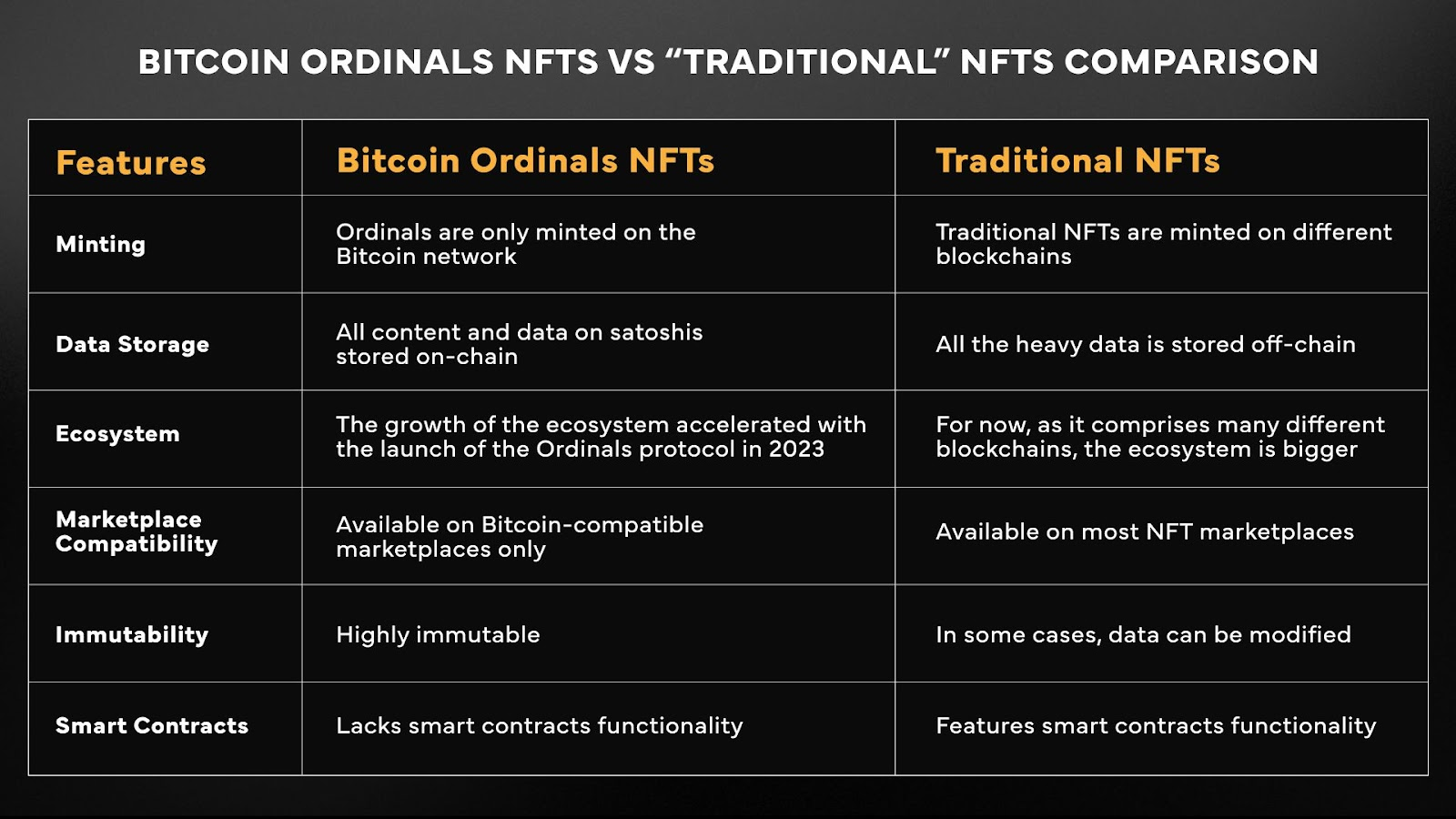Bitcoin
Bitcoin CPI
Venture Portfolio
Funds
Market Insights
Indicators
About
Contact

July 31, 2025





The Ordinals protocol has simplified the creation of digital artifacts on the Bitcoin blockchain, which is causing an explosion of NFTs on this biggest, most decentralized, and secure chain.
In this guide, you’ll learn what Bitcoin non-fungible tokens (NFTs) are, their history, how they work, and differ from traditional NFTs, as well as how Ordinals affect the whole Bitcoin ecosystem.
Bitcoin NFTs, as the name suggests, are non-fungible tokens on the Bitcoin blockchain.
While it was possible to create unique digital tokens on Bitcoin even before the Ordinals protocol was launched in 2023 by developer Casey Rodarmor, this solution made the whole process much simpler. This effectively created a whole new class of Bitcoin NFTs, introduced a new player in the NFT market, and increased competition with other blockchains.
NFTs created with the help of the Ordinals protocol are interchangeably called Ordinals or inscriptions. They’re created by inscribing data onto satoshis, the smallest unit of Bitcoin.
Each satoshi, which is numbered by the rules of the Ordinals protocol, can be inscribed with different types of data, such as text, images, videos, other types of files, and even video games.
Before this protocol went live, one way to upload NFTs onto the Bitcoin blockchain was by using Bitcoin scaling solutions, including Layer 2s (L2s), such as Liquid Network, Stacks, and Rootstock.
Now, thanks to Ordinals, a new class of Bitcoin NFTs can be inscribed directly onto this blockchain without needing to change its code or use other chains.
“The Ordinals protocol has effectively turned the Bitcoin network into a multipurpose chain. I expect to see more on-chain innovation and use cases as a result.” - Patrick Lowry, CEO at Samara Asset Group.

Some believe the mysterious creator of Bitcoin, Satoshi Nakamoto, was also the author of the first-ever NFT. In the Genesis block, or the first block of the Bitcoin blockchain, Satoshi added the iconic line from The Times newspaper of that day, reading: “The Times 03/Jan/2009 Chancellor on brink of second bailout for banks.”
Another step toward non-fungible tokens on Bitcoin was taken with the implementation of Colored Coins in 2012. This protocol helped mark bitcoins to have them, for example, represent and assign ownership of assets such as bonds, real estate, and stocks. However, the project had limited practical applications and faced scalability challenges that hindered its widespread adoption.
Since then, integrating NFTs into the Bitcoin network has undergone several iterations. Below are some of the milestones in the history of Bitcoin NFTs.
In 2014, the Counterparty platform emerged as another attempt to bring NFTs to Bitcoin. It expanded Bitcoin’s functionality by introducing a layer on the Bitcoin blockchain, which enabled the creation and trading of digital assets like NFTs.
One of the popular NFT projects introduced via Counterparty in 2016 was Rare Pepe. This was before the term 'NFTs' was even in use, and Ethereum NFTs didn’t yet exist. Minted in limited numbers on Counterparty, the Rare Pepe images featured Pepe the Frog memes and resembled physical trading cards.
Like Colored Coins, Counterparty experienced network efficiency and user experience challenges.
After the initial failures, the concept of Bitcoin NFTs has undergone a resurgence driven by new protocols and technological advancements.
The introduction of various scaling solutions, such as Layer 2 protocols, brought changes to the Bitcoin ecosystem, with the primary focus being to expand its use cases. Stacks, Rootstock, and the Liquid Network are among the oldest Bitcoin L2s that introduced ways to create Bitcoin NFTs.
These protocols allowed creators to upload NFTs to Bitcoin without altering its main protocol.
For example, an NFT marketplace, Carnaval, launched on Rootstock to allow the minting of unique artwork on Bitcoin. Stacks supports various decentralized applications (dApps) and smart contract platforms that leverage Bitcoin’s decentralization and security to achieve many things, including the creation of Bitcoin NFTs.
These scaling solutions have helped to reintroduce Bitcoin-based NFTs by providing more user-friendly processes.
The launch of the Ordinals protocol marked a significant milestone for NFT creation directly on the Bitcoin network. Rodarmor’s proposal to have arbitrary data inscribed onto satoshis offered a new avenue for NFT creation on Bitcoin without changing its primary protocol or relying on separate blockchains.
Ordinals inscriptions were made possible by primarily two Bitcoin upgrades, which mostly increased Bitcoin’s block capacity: SegWit and Taproot.
The Ordinals protocol leveraged Bitcoin’s security to ensure Ordinal inscriptions remained fully on-chain, stored inside the script of a Taproot transaction input. Initially, inscribers could only attach up to 4MB of data on each satoshi.
With the launch of recursive inscriptions, Ordinal inscriptions can now support data from other existing inscriptions, allowing for the creation of more complex projects.
Since the launch of the Ordinals protocol, some popular NFT collections that have emerged include Ordinal Punks, Taproot Wizards, Quantum Cats, Bitcoin Frogs, and others.
Thanks to Ordinals, Bitcoin is now in the top three blockchains by NFT sales volume, overtaking some of the older players in the market.
The Ordinals protocol describes a system for sequencing satoshis in a manner that creates the non-fungible aspect necessary for the creation of NFTs.
According to Ordinal Theory, it involves numbering each satoshi in the order in which it was mined. The Ordinals protocol is designed to assign additional information to the serial number of each satoshi. This additional data is what’s known as an inscription.
Ordinal inscriptions are essentially the content of Bitcoin Ordinals NFTs, such as GIFs, images, text, video, or any other relevant data that a developer considers connected to their NFTs.
Given that Ordinal inscriptions are inscribed on satoshis, they inherit the decentralization, immutability, and security of the Bitcoin network itself.
While the first NFTs were on Bitcoin, NFTs on other blockchains, especially Ethereum, are now considered “traditional”. The Bitcoin NFTs differ from traditional NFTs in several ways.
To start with, Bitcoin Ordinals NFTs can only be minted on the Bitcoin protocol, and all their data is stored on-chain. Meanwhile, traditional NFTs store all their large data off-chain.
Additionally, while Bitcoin NFTs are still growing, traditional NFTs have a broader, more diverse, and liquid ecosystem.
For instance, OpenSea, one of the largest NFT marketplaces, doesn’t support Ordinals, but you can still find Bitcoin and/or Ordinals-pretending NFTs that are minted on other blockchains. Meanwhile, real Ordinals can be found on platforms such as Magic Eden or Gamma.
Bitcoin NFTs are also considered to be immutable and more secure, as this blockchain lacks smart contract functionality, while data on traditional NFTs can, in some cases, be altered.
Here’s how these two types of NFTs compare.

The effects of the Ordinals protocol on Bitcoin are as diverse as the NFT market it helped to create.
By uploading NFTs to this blockchain, creators increase demand for Bitcoin block space and BTC. The fees for uploading Ordinals have to be paid in satoshis.
Concurrently, higher revenue from fees strengthens hopes that, in the long term, it might make Bitcoin miners' revenues more sustainable as their block reward gets cut in half every four years during the Bitcoin halving event.
While this demand for block space is also increasing the fees for BTC transactions, the latter issue is being addressed by developing various Bitcoin scaling solutions.
Additionally, the Ordinals protocol has inspired other developments and protocols, such as the BRC-20 token standard for creating fungible tokens on Bitcoin, which was later improved with the Runes standard. Meanwhile, with the invention of recursive inscriptions, some estimate that more complicated artwork or even DeFi projects can be developed on Bitcoin.
All these developments have helped attract new builders, users, and investors to the Bitcoin network.
Ordinals have also fostered a debate within the Bitcoin community about the usefulness of Bitcoin NFTs, how this network should evolve further, and what devs should focus on.
Bitcoin NFTs have several use cases and applications. The following are some of the most notable:
Bitcoin Ordinals are still in their nascent stage, having only been introduced in January 2023. However, their popularity since launch has enabled many creators to upload unique and scarce digital assets on the Bitcoin blockchain, making it an important player in the NFT market and increasing demand for Bitcoin.
With additional development and improvements in the Bitcoin ecosystem, creators can expect more tools and features, allowing for the creation of more innovative and complex projects, whether in art or other domains.
If you’re a Bitcoin NFT collector, going forward, you can expect a better experience when interacting with, storing, and trading these digital artifacts, while the industry is likely to see more Ordinals-supporting marketplaces.
To create a Bitcoin Ordinal NFT, you’ll first need to download and set up a Taproot-enabled Bitcoin wallet. After backing up your wallet, purchase BTC and transfer it to your Taproot-enabled wallet. Next, proceed to create an NFT using platforms like Gamma, Magic Eden, or OrdinalsBot. Once the Bitcoin Ordinal NFT is created, pay the necessary fees and broadcast it on the Bitcoin network. And that’s it!
You can get Bitcoin NFTs on Ordinal or NFT marketplaces that are compatible with the Bitcoin blockchain. Some of the Bitcoin NFT marketplaces where you can get Bitcoin NFTs include Gamma, Magic Eden, OpenOrdex, and Ordinals Wallet.
Bitcoin NFTs are most often used for creating, collecting, and trading artwork based on the Bitcoin blockchain, but they can also be used for different purposes, like gaming, data storage, and provenance tracking, among others.